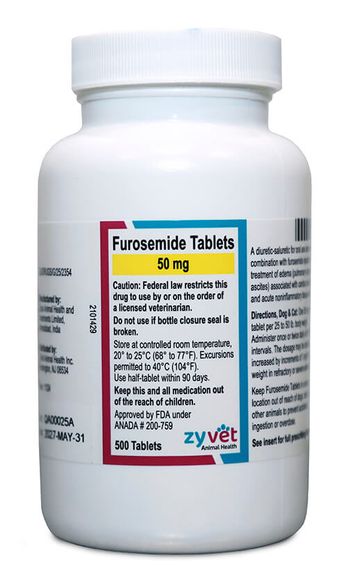
Cardiac therapy: New treatment modalities emerge
Dr. Bonnie K. Lefbom at the 2005 American College of Veterinary Internal Medicine Forum in Baltimore gave a lecture on sildenafil and novel cardiovascular therapies.
Q. Please review some new cardiac drugs that can be used in clinical practice today.
A. Dr. Bonnie K. Lefbom at the 2005 American College of Veterinary Internal Medicine Forum in Baltimore gave a lecture on sildenafil and novel cardiovascular therapies. Some relevant points in this lecture and current information about ramipril are provided below.
New treatment modalities often arise in cardiac therapy. Sildenafil was initially disregarded in its development as a useful tool for coronary heart disease. However, the discovery that sildenafil was effective to combat impotence transformed into a breakthrough therapy for individuals suffering from debilitating pulmonary hypertension. Pimobendan, a drug initially discounted because former drugs in its class were shown to predispose to life-threatening arrhythmias, has combined vasodilator and positive inotropic effects via phosphodiesterase inhibition. Pimobendan is emerging as therapy for dogs with late-stage contractile failure. Nutraceutical therapy always has been under scrutiny. B-vitamin complex therapy, however, has been shown to decrease circulating levels of homocysteine. High homocysteine levels increase risk for thrombotic events.
Sildenafil
Sildenafil was introduced in 1998 under the trademark of Viagra and received intense media coverage of any newly approved drug. The mechanism of action is via inhibition of cGMP degradation via specific phosphodiesterase-5 (PDE-5) inhibition. PDE-5 is plentiful in vascular, tracheal and visceral smooth muscle. Nitric oxide (NO) and cGMP act synergistically to reduce calcium release from intracellular stores and serve to improve smooth-muscle relaxation allowing arterial dilation in several clinical examples. Clinically, there are few alternatives to treat individuals with debilitating pulmonary hypertension (PHT). Sildenafil recently has been demonstrated in human cardiology to decrease the severity of PHT in both primary (unknown cause) and secondary disease, including left-sided congestive heart failure (CHF). In fact, a single dose of sildenafil has been shown to be a selective pulmonary vasodilator and may even be superior to inhaled NO based on its increase in cardiac output with no increase in capillary wedge pressure. Veterinary cardiologists now are adding this drug as an adjunct to traditional pulmonary hypertension therapy. Initial clinical results using a dose of 1-3 mg/kg two to four times daily have been promising.
Pimobendan
Pimobendan is a benzimidazole derivative that exerts its positive inotropic and vasodilatory actions through both calcium sensitization and phosphodiesterase inhibition. Initial reports in human medicine from Europe and Japan suggested beneficial effects of pimobendan on the neurohumoral factors when added to standard therapy for individuals with moderate (NYHA functional class II-III) heart failure. Subsequent larger-scale trials in human patients on pimobendan demonstrated decreases in morbidity (not mortality) and increases in physical activity of human patients with mild to moderate CHF. Initial small-scale trials with English Cocker Spaniels (ECS) and Doberman Pinschers (DP) demonstrated significant improvement in heart failure class for both the ECS and DP groups when pimobendan was added to standard triple therapy for heart failure (furosemide, digoxin and enalapril). Also, a marked improvement in survival times was demonstrated in the DP group on pimobendan compared to DP dogs on standard triple therapy and placebo. No significant change in survival times for ECS dogs was noted. A second small-scale study confirmed the positive effects on both quality and duration of life in DP dogs when given pimobendan as adjunct therapy for congestive heart failure. The two larger trials attempted to compare the effects of ACE inhibition with pimobendan. The clinical status of dogs on pimobendan was improved compared with ACE inhibitors. However, no statistical differences were found in hospitalization rates or maximum diuretic doses required to maintain dogs out of heart failure. Pimobendan was shown to have fewer adverse outcome reports when compared to ramipril and does appear to be safe in congestive heart failure in dogs. The currently accepted dose is 0.2 to 0.3 mg/kg twice daily.
As with all newly released pharmaceuticals, caution with the use of pimobendan is warranted until larger-scale trials are completely analyzed, true benefits are outlined and potential side effects disclosed.
Ramipril
Ramipril is another ACE inhibitor that is now available in the United States. Ramipril is converted in vivo to its active form, ramiprilat, which is eliminated in the bile and urine. No adjustment of the recommended oral dosage of ramipril is needed in dogs with moderate renal impairment.
In addition, the dose rate of ramipril recommended for dogs (0.125 mg/kg once daily) proves to be adequate in most cases and improved the clinical signs in the cats with hypertensive and normotensive cats suffering from hypertrophic cardiomyopathy (HCM). Side effects occur infrequently in dogs and cats. Not to be used in hemodynamically relevant stenoses (e.g. aortic stenosis, mitral-valve stenosis) or obstructive hypertrophic cardiomyopathy. If signs of apathy or ataxia (potential signs of hypotension) occur during treatment with ramipril, the drug should be discontinued and treatment resumed at 50 percent of the original dose once signs have subsided.
The use of ACE inhibitors in dogs with hypovolemia/severe dehydration (e.g. as a result of diuretic treatment, vomiting and/or diarrhea) can lead to acute hypotension. Ramipril treatment not only appears to be safe in combination with furosemide but also with feline thyrostatic therapy.
B vitamins and folic acid
Both cobalamin and folic acid are integral components of the metabolism of homocysteine. Hyperhomo-cysteinemia in human patients is associated with increased risks for both venous and arterial thrombosis as well as cardiac mortality.
Folate therapy (combined supplementation of vitamins B6, cobalamin and folic acid) has been demonstrated to significantly lower homocysteine levels. However, lower homocysteine levels have resulted in variable success for the prevention of peripheral vascular events in human trials.
Arterial thromboembolism (ATE) in cats often present to veterinary practices. In light of the strong data in human cardiology supporting hyperhomocysteinemia as a risk factor for peripheral vascular disease, similar data has been analyzed in cats. Interestingly, no differences in homocysteine or folate levels were found between groups of normal cats, cats with cardiomyopathy (CM), and cats with CM and ATE. Cobalamin concentrations, however, were lower in both the cats with CM alone and cats with combined CM and ATE. The current empiric dose recommendation for B vitamin complex adjunct therapy in cats is 12.5 mg once daily. More research is needed to determine if cats truly benefit from B12 or folate therapy. As veterinarians attempting above all to do no harm, combined B vitamin therapy seems to be a reasonable adjunct to more traditional therapies in our efforts to decrease the risk of feline arterial thromboembolism.
What's your question? Send your pediatric/geriatric related questions to: Pediatric/Geriatric Protocol, DVM Newsmagazine, 7500 Old Oak Blvd., Cleveland, OH 44130. Your questions will be answered by Dr. Hoskins in upcoming columns.
Dr.Johnny Hoskins is owner of DocuTech Services. He is a diplomate of the American College of Veterinary Internal Medicine with specialities in small animal pediatrics. He can be reached at (225) 955-3252, fax: (214) 242-2200, or e-mail:
Newsletter
From exam room tips to practice management insights, get trusted veterinary news delivered straight to your inbox—subscribe to dvm360.






